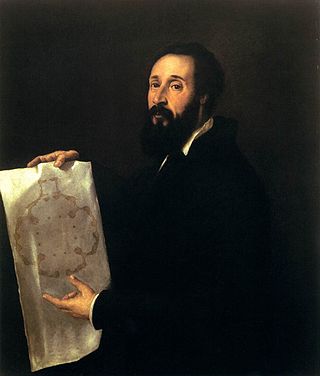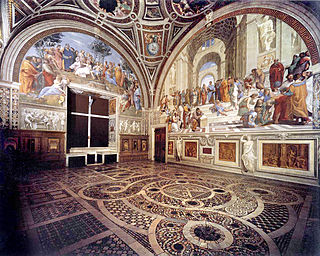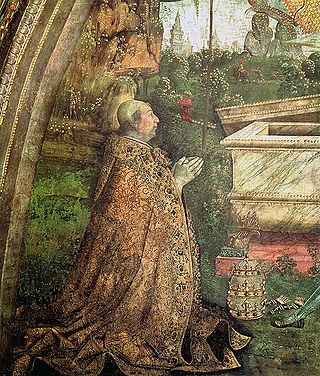
Raffaello Sanzio da Urbino, now generally known in English as Raphael, was an Italian painter and architect of the High Renaissance. His work is admired for its clarity of form, ease of composition, and visual achievement of the Neoplatonic ideal of human grandeur. Together with Leonardo da Vinci and Michelangelo, he forms the traditional trinity of great masters of that period.

The Apostolic Palace is the official residence of the Pope, the head of the Catholic Church, located in Vatican City. It is also known as the Papal Palace, the Palace of the Vatican and the Vatican Palace. The Vatican itself refers to the building as the Palace of Sixtus V, in honor of Pope Sixtus V, who built most of the present form of the palace.

Giulio Pippi, known as Giulio Romano, was an Italian painter and architect. He was a pupil of Raphael, and his stylistic deviations from High Renaissance classicism help define the sixteenth-century style known as Mannerism. Giulio's drawings have long been treasured by collectors; contemporary prints of them engraved by Marcantonio Raimondi were a significant contribution to the spread of sixteenth-century Italian style throughout Europe.

The four Raphael Rooms form a suite of reception rooms in the Apostolic Palace, now part of the Vatican Museums, in Vatican City. They are famous for their frescoes, painted by Raphael and his workshop. Together with Michelangelo's Sistine Chapel ceiling frescoes, they are the grand fresco sequences that mark the High Renaissance in Rome.

Gianfrancesco Penni (1488/1496–1528), also known as Giovan Francesco, was an Italian painter. His brother Bartolommeo was an artist of the Tudor court of Henry VIII, and another brother, Luca, ended up as one of the Italian artists of the School of Fontainebleau.

The Transfiguration is the last painting by the Italian High Renaissance master Raphael. Cardinal Giulio de Medici – who later became Pope Clement VII – commissioned the work, conceived as an altarpiece for Narbonne Cathedral in France; Raphael worked on it in the years preceding his death in 1520. The painting exemplifies Raphael's development as an artist and the culmination of his career. Unusually for a depiction of the Transfiguration of Jesus in Christian art, the subject is combined with the next episode from the Gospels in the lower part of the painting. The work is now in the Pinacoteca Vaticana in the Vatican City.

The Borgia Apartments are a suite of rooms in the Apostolic Palace in the Vatican, adapted for personal use by Pope Alexander VI. In the late 15th century, he commissioned the Italian painter Bernardino di Betto (Pinturicchio) and his studio to decorate them with frescoes.

The Disputation of the Sacrament, or Disputa, is a painting by the Italian Renaissance artist Raphael. It was painted between 1509 and 1510 as the first part of Raphael's commission to decorate with frescoes the rooms that are now known as the Stanze di Raffaello, in the Apostolic Palace in the Vatican. At the time, this room was known as the Stanza della Segnatura, and was the private papal library where the supreme papal tribunal met.

The Parnassus is a fresco painting by the Italian High Renaissance artist Raphael in the Raphael Rooms, in the Palace of the Vatican in Rome, painted at the commission of Pope Julius II.

The Liberation of Saint Peter is a fresco painting by the Italian High Renaissance artist Raphael. It was painted in 1514 as part of Raphael's commission to decorate with frescoes the rooms that are now known as the Stanze di Raffaello, in the Apostolic Palace in the Vatican. It is located in the Stanza di Eliodoro, which is named after The Expulsion of Heliodorus from the Temple. The painting shows how Saint Peter was liberated from Herod's prison by an angel, as described in Acts 12. It is technically an overdoor.

The Vision of the Cross is a painting made between 1520 and 1524 by assistants of the Italian renaissance artist Raphael. After the master's death in 1520, Gianfrancesco Penni, Giulio Romano and Raffaellino del Colle from Raphael's workshop worked together to finish the commission to decorate with frescoes the rooms that are now known as the Stanze di Raffaello, in the Apostolic Palace in the Vatican.

The Mass at Bolsena is a painting by the Italian renaissance artist Raphael. It was painted between 1512 and 1514 as part of Raphael's commission to decorate with frescoes the rooms that are now known as the Raphael Rooms, in the Apostolic Palace in the Vatican. It is located in the Stanza di Eliodoro, which is named after The Expulsion of Heliodorus from the Temple.

The Coronation of Charlemagne is a painting by the workshop of the Italian Renaissance artist Raphael. Though it is believed that Raphael did make the designs for the composition, the fresco was probably painted by Gianfrancesco Penni. The painting was part of Raphael's commission to decorate the rooms that are now known as the Stanze di Raffaello, in the Apostolic Palace in the Vatican. It is located in the room that was named after The Fire in the Borgo, the Stanza dell'incendio del Borgo.

The Oath of Leo III is a painting by the workshop of the Italian renaissance artist Raphael. The painting was part of Raphael's commission to decorate the rooms that are now known as the Stanze di Raffaello, in the Apostolic Palace in the Vatican. It is located in the room that was named after The Fire in the Borgo, the Stanza dell'incendio del Borgo. In the fresco, Pope Leo III is seen during the trial on December 23 AD 800 during which he was brought face to face with the nephews of his predecessor Pope Hadrian I, who had accused him of misconduct. The assembled bishops declared that they could not judge the pope, after which Leo took an oath of purgation of his own free will.

The Meeting of Leo I and Attila is a fresco by the Italian Renaissance artist Raphael. It was painted from 1513 to 1514 as part of Raphael's commission to decorate the rooms that are now known as the Stanze di Raffaello, in the Apostolic Palace in the Vatican. It is located in the Stanza di Eliodoro, which is named after The Expulsion of Heliodorus from the Temple.

The Donation of Constantine or Donation of Rome is a painting by assistants of the Italian renaissance artist Raphael. It was most likely painted by Gianfrancesco Penni or Giulio Romano, somewhere between 1520 and 1524. After the master's death in 1520, they worked together with other members of Raphael's workshop to finish the commission to decorate with frescoes the rooms that are now known as the Stanze di Raffaello, in the Apostolic Palace in the Vatican. The Donation of Constantine is located in the Sala di Costantino. It was inspired by the famous forged documents that supposedly granted the Popes sovereignty over Rome's territorial dominions.

The Battle of the Milvian Bridge, or The Battle at Pons Milvius, is a fresco in one of the rooms that are now known as the Stanze di Raffaello, in the Apostolic Palace in the Vatican depicting the Battle of the Milvian Bridge.

The Cardinal and Theological Virtues is a lunette fresco by Raphael found on the south wall of the Stanza della Segnatura in the Apostolic Palace of the Vatican. Three of the cardinal virtues are personified as statuesque women seated in a bucolic landscape, and the theological virtues are depicted by putti.

The Renaissance in Rome occupied a period from the mid-15th to the mid-16th centuries, a period which spawned such masters as Michelangelo and Raphael, who left an indelible mark on Western figurative art. The city had been a magnet for artists wishing to study its classical ruins since the early 15th century. A revived interest in the Classics brought about the first archaeological study of Roman remains by the architect Filippo Brunelleschi and the sculptor Donatello. This inspired a corresponding classicism in painting and sculpture, which manifested itself in the paintings of Masaccio and Uccello. Pisanello and his assistants also frequently took inspiration from ancient remains, but their approach was essentially cataloguing, acquiring a repertoire of models to be exploited later.

The Acts of Sylvester are a series of legendary tales about the fourth-century bishop of Rome, Sylvester I. Sylvester was the bishop of Rome at the critical point in European history when Constantine the Great became the first Christian emperor. Yet, despite the claims that arose in later centuries of Roman primacy, some academics question whether Sylvester played a significant role in the Christianization of the Roman Empire during this crucial period. They contend these legends arose in order to augment the reputation of Sylvester and to correct a number of embarrassing events for the Church, such as his conspicuous absence at both the Synod of Arles in 314 and the First Council of Nicaea in 325, and the fact that Constantine had been baptized by an Arian bishop.




















